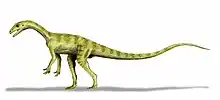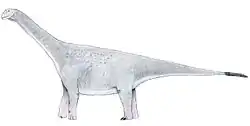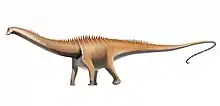| Astrophocaudia Temporal range: Early Cretaceous, | |
|---|---|
 | |
| Scientific classification | |
| Domain: | Eukaryota |
| Kingdom: | Animalia |
| Phylum: | Chordata |
| Clade: | Dinosauria |
| Clade: | Saurischia |
| Clade: | †Sauropodomorpha |
| Clade: | †Sauropoda |
| Clade: | †Macronaria |
| Clade: | †Somphospondyli |
| Genus: | †Astrophocaudia D’Emic, 2012 |
| Type species | |
| †Astrophocaudia slaughteri D’Emic, 2012 | |
Astrophocaudia (meaning "non-twisting tail"; alternately "star tail" in reference to Astrodon[1]) is a genus of somphospondylan sauropod known from the late Early Cretaceous (Albian stage) of Texas, United States. Its remains were discovered in the Trinity Group. The type species is Astrophocaudia slaughteri, described in 2012 by Michael D. D’Emic while a doctoral student at the Museum of Paleontology of the University of Michigan, USA. [1]
Discovery and naming
In 1969, Maria A. Marques-Bilelo reported the holotype from the Trinity Group.[2] In 1974, Wann Langston Jr. referred the fossil to Pleurocoelus (now considered a junior synonym of Astrodon) as a Pleurocoelus sp. In 2012, Michael D'Emic renamed Pleurocoelus sp. as Astrophocaudia slaughteri in his redescription of the Trinity Group sauropods.[1]
The holotype is a partial skeleton originally including two teeth, two neck vertebrae, fragments of back vertebrae, 21 tail vertebrae, approximately 20 fragmentary ribs, two chevrons, and a piece of shoulder blade however the two teeth were found to be prezygapophysis processes from the middle centra and three additional vertebrae which were previously assigned to turtles were found to be sauropod vertebrae from the skeleton itself as well as an additional tooth[1]
References
- 1 2 3 4 D’Emic, Michael D. (2012). "Revision of the sauropod dinosaurs of the Lower Cretaceous Trinity Group, southern USA, with the description of a new genus". Journal of Systematic Palaeontology. 11 (6): 707–726. doi:10.1080/14772019.2012.667446. S2CID 84742205.
- ↑ "DinoChecker dinosaur archive".










